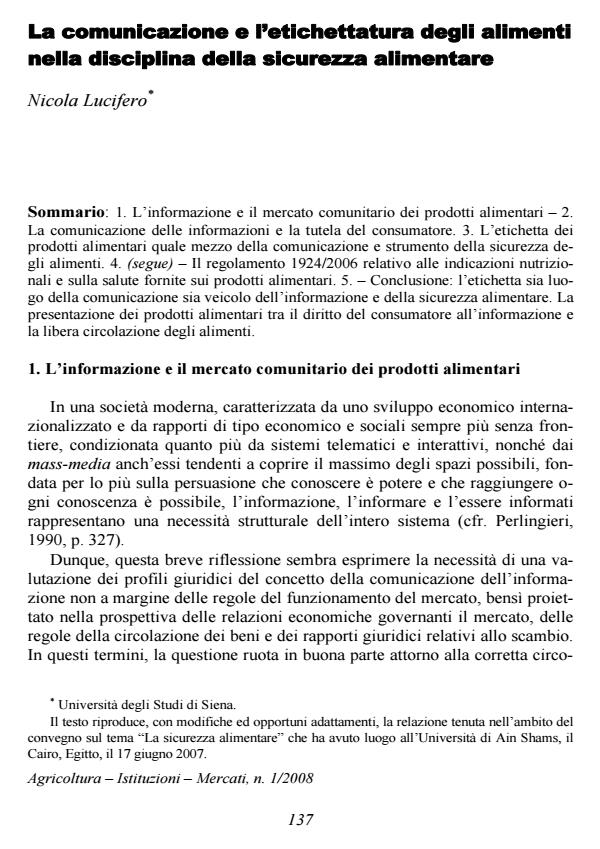La comunicazione e l’etichettatura degli alimenti nella disciplina della sicurezza alimentare
Journal title AGRICOLTURA ISTITUZIONI MERCATI
Author/s Nicola Lucifero
Publishing Year 2009 Issue 2008/1
Language Italian Pages 23 P. 137-159 File size 278 KB
DOI 10.3280/AIM2008-001010
DOI is like a bar code for intellectual property: to have more infomation
click here
Below, you can see the article first page
If you want to buy this article in PDF format, you can do it, following the instructions to buy download credits

FrancoAngeli is member of Publishers International Linking Association, Inc (PILA), a not-for-profit association which run the CrossRef service enabling links to and from online scholarly content.
Communication and Food Labelling within the Discipline of Food Safety - The current market is governed by an information system, but it is also regulated by interests specific to the discipline of food safety. Therefore, it highlights the close bond between the contents of the contract and the contents of the information, as well as the equally tight correlation between information and competition. In fact, the legislator aims to reconcile the need for food safety with that for the circulation of goods. It must also be added that food safety is a discipline, first and foremost, concerned with product marketing, and thus the rules on information provided for by the common legislator are instrumental to the achievement of a common market of safe and healthy foods, a market governed by rules of communication that facilitate exchanges and guarantee the circulation of foods. From this perspective, within the discipline of food safety information has a double aim, as it strives to provide the market with that symmetry of information essential to its functioning while safeguarding the interests of food safety. Hence, we can understand the legal weight, within the food market, of labels, which can be seen as both the "space" in which communication takes place and a vehicle for information. It is in this context that the food labelling law, eventually regulated by directive 2000/13, originates and develops. However, the legal function of labels cannot be regarded exclusively as a tool for the satisfaction of the need to inform and safeguard consumers and facilitate exchanges between member states, but it should exist in a framework that encompasses the whole food safety legal sys158 tem (reg. 178/2002). The general rules governing the food safety system are thus revealed, as well as the indications, compulsory and non, to be placed on the labels, both with regard to their content and the way this information is conveyed. In this context, we can see the relevance of the very recent reg. 1924/2006 of December 20th 2006 on the nutritional values of foods and their effects on health. Key words: food security, comunication, labelling, consumer protection.
Nicola Lucifero, La comunicazione e l’etichettatura degli alimenti nella disciplina della sicurezza alimentare in "AGRICOLTURA ISTITUZIONI MERCATI " 1/2008, pp 137-159, DOI: 10.3280/AIM2008-001010